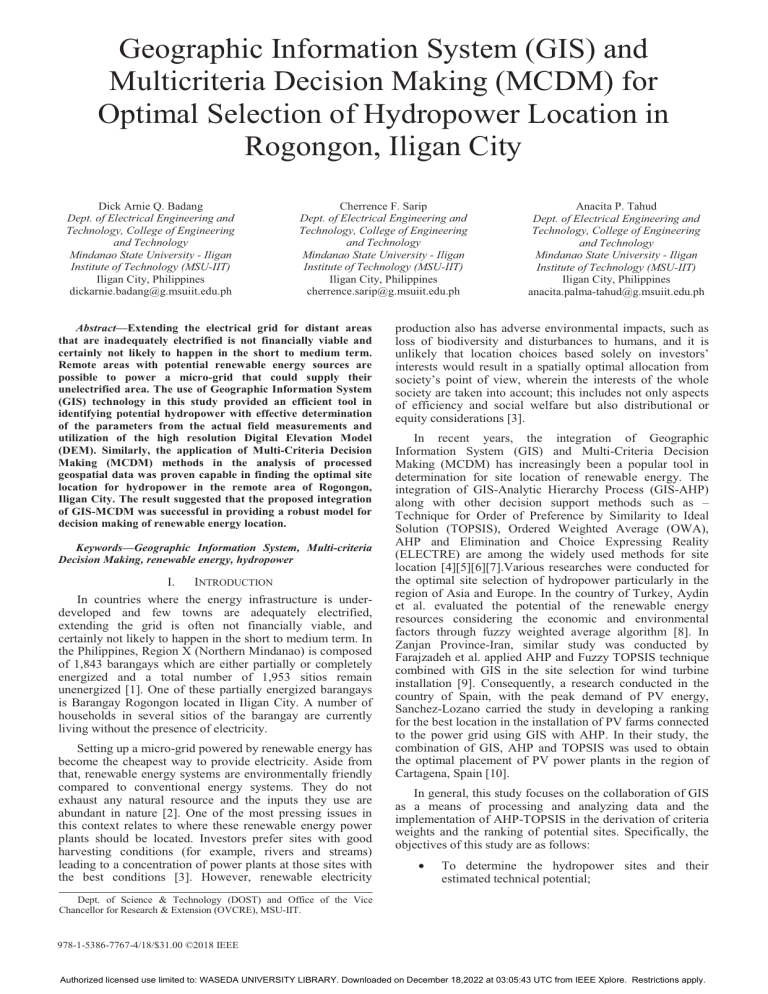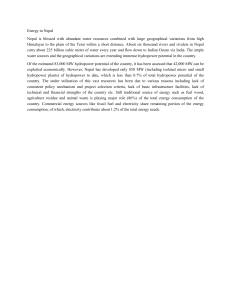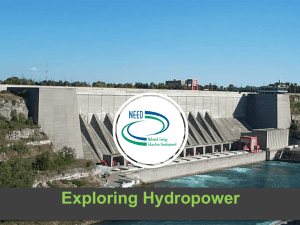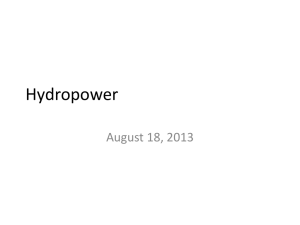
Geographic Information System (GIS) and Multicriteria Decision Making (MCDM) for Optimal Selection of Hydropower Location in Rogongon, Iligan City Dick Arnie Q. Badang Dept. of Electrical Engineering and Technology, College of Engineering and Technology Mindanao State University - Iligan Institute of Technology (MSU-IIT) Iligan City, Philippines dickarnie.badang@g.msuiit.edu.ph Cherrence F. Sarip Dept. of Electrical Engineering and Technology, College of Engineering and Technology Mindanao State University - Iligan Institute of Technology (MSU-IIT) Iligan City, Philippines cherrence.sarip@g.msuiit.edu.ph Abstract—Extending the electrical grid for distant areas that are inadequately electrified is not financially viable and certainly not likely to happen in the short to medium term. Remote areas with potential renewable energy sources are possible to power a micro-grid that could supply their unelectrified area. The use of Geographic Information System (GIS) technology in this study provided an efficient tool in identifying potential hydropower with effective determination of the parameters from the actual field measurements and utilization of the high resolution Digital Elevation Model (DEM). Similarly, the application of Multi-Criteria Decision Making (MCDM) methods in the analysis of processed geospatial data was proven capable in finding the optimal site location for hydropower in the remote area of Rogongon, Iligan City. The result suggested that the proposed integration of GIS-MCDM was successful in providing a robust model for decision making of renewable energy location. Keywords—Geographic Information System, Multi-criteria Decision Making, renewable energy, hydropower I. INTRODUCTION In countries where the energy infrastructure is underdeveloped and few towns are adequately electrified, extending the grid is often not financially viable, and certainly not likely to happen in the short to medium term. In the Philippines, Region X (Northern Mindanao) is composed of 1,843 barangays which are either partially or completely energized and a total number of 1,953 sitios remain unenergized [1]. One of these partially energized barangays is Barangay Rogongon located in Iligan City. A number of households in several sitios of the barangay are currently living without the presence of electricity. Setting up a micro-grid powered by renewable energy has become the cheapest way to provide electricity. Aside from that, renewable energy systems are environmentally friendly compared to conventional energy systems. They do not exhaust any natural resource and the inputs they use are abundant in nature [2]. One of the most pressing issues in this context relates to where these renewable energy power plants should be located. Investors prefer sites with good harvesting conditions (for example, rivers and streams) leading to a concentration of power plants at those sites with the best conditions [3]. However, renewable electricity Anacita P. Tahud Dept. of Electrical Engineering and Technology, College of Engineering and Technology Mindanao State University - Iligan Institute of Technology (MSU-IIT) Iligan City, Philippines anacita.palma-tahud@g.msuiit.edu.ph production also has adverse environmental impacts, such as loss of biodiversity and disturbances to humans, and it is unlikely that location choices based solely on investors’ interests would result in a spatially optimal allocation from society’s point of view, wherein the interests of the whole society are taken into account; this includes not only aspects of efficiency and social welfare but also distributional or equity considerations [3]. In recent years, the integration of Geographic Information System (GIS) and Multi-Criteria Decision Making (MCDM) has increasingly been a popular tool in determination for site location of renewable energy. The integration of GIS-Analytic Hierarchy Process (GIS-AHP) along with other decision support methods such as – Technique for Order of Preference by Similarity to Ideal Solution (TOPSIS), Ordered Weighted Average (OWA), AHP and Elimination and Choice Expressing Reality (ELECTRE) are among the widely used methods for site location [4][5][6][7].Various researches were conducted for the optimal site selection of hydropower particularly in the region of Asia and Europe. In the country of Turkey, Aydin et al. evaluated the potential of the renewable energy resources considering the economic and environmental factors through fuzzy weighted average algorithm [8]. In Zanjan Province-Iran, similar study was conducted by Farajzadeh et al. applied AHP and Fuzzy TOPSIS technique combined with GIS in the site selection for wind turbine installation [9]. Consequently, a research conducted in the country of Spain, with the peak demand of PV energy, Sanchez-Lozano carried the study in developing a ranking for the best location in the installation of PV farms connected to the power grid using GIS with AHP. In their study, the combination of GIS, AHP and TOPSIS was used to obtain the optimal placement of PV power plants in the region of Cartagena, Spain [10]. In general, this study focuses on the collaboration of GIS as a means of processing and analyzing data and the implementation of AHP-TOPSIS in the derivation of criteria weights and the ranking of potential sites. Specifically, the objectives of this study are as follows: • To determine the hydropower sites and their estimated technical potential; Dept. of Science & Technology (DOST) and Office of the Vice Chancellor for Research & Extension (OVCRE), MSU-IIT. 978-1-5386-7767-4/18/$31.00 ©2018 IEEE Authorized licensed use limited to: WASEDA UNIVERSITY LIBRARY. Downloaded on December 18,2022 at 03:05:43 UTC from IEEE Xplore. Restrictions apply. • To determine the weights of the selected criteria based on judgments by experts; • To rank the suitable areas according to the selected criteria; and • To create a thematic map for hydropower sites classified according to their ranking value. This study is part of the “Techno-Economic Feasibility Study of Micro-Grid in a Remote Community” Project, a research project of MSU-IIT funded by the Department of Science and Technology (DOST). The information derived from this study is helpful to policy makers and concerned agencies in hydro energy resource management, planning and development. Furthermore, this could provide a current and reliable assessment for possible investors and hence greatly benefit the community involved. II. METHODOLOGY A. The Study Area Rogongon, one of the 44 barangays in Iligan City, Philippines with total land area of 35,555 hectares (355.55 km2) represents about 44% of the total land area of the city. It is located northwestern part of the city and is bounded on the north by portion of Province of Misamis Oriental and Cagayan de Oro City; on the east by Province of Bukidnon; on the south by Barangay Kalilangan and Panoroganan; and on the west by Barangay Digkila-an. Majority of the inhabitants in Brgy. Rogongon are Indigenous People (IP), specifically “Higaunons”. The ancestral domain area is endowed with rich water resources and has promising hydropower potential [11]. However, since it is situated in the remotest part of Iligan, majority of the area still has no access to electricity, which is a major hindrance to its economic development. The study area is composed of selected sitios in the barangay. These sitios and their corresponding number of households are listed in Table 1 while their locations are shown in Fig. 1. TABLE I. SELECTED SITIOS (IN BRGY. ROGONGON, ILIGAN CITY) WITHOUT ACCESS TO ELECTRICITY Sitio Malagsum Gabunan Libandayan Languisan Salingsing Number of households 25 20 18 15 25 Fig. 1. Study Area in Rogongon, Iligan City B. Development of Hydropower Potential Sites There were 696 identified hydropower potential sites along the stream networks of Brgy. Rogongon [11]. Some of these hydropower potential sites are found along Icog River and Malagsum River, which are near the target sitios. For data processing of hydropower installation, these sites were validated and other necessary data were obtained by conducting an actual flow measurement in the study area. Equation (1) was used to derive the technical potential of each potential site [12]. ܲ ൌ ߟ௧ ߟ ߩ݃ܳܪ (1) where, P = Power Output (kW) ߟ௧ = Turbine efficiency (85%) ߟ = Generator efficiency (95%) = Density of water (1000 kg/m3) g = Acceleration due to gravity (9.81 m/s2) Q = Plant discharge (m3/s) H = Effective head (m); with head loss = 10% Moreover, the project cost can be derived by determining the turbine classification, head and flow rate of the potential river stream. Particularly for this study, the turbine type for all six potential sites lies in the Kaplan class. The sum of electromechanical cost, ܥாெ in (2), and turbine cost, ܥ in (3), was used to estimate the project cost of each alternative sites [13]. ܥாெ ൌ ͳʹǡ ͲͲͲ ൈ ቀ ௐ Ǥହ ு బǤమ ቁ ͉ ܥ ൌ ͳͷǡ ͲͲͲ ൈ ሺܳ ൈ ܪሻǤ଼ ͉ (2) (3) C. Multi-criteria Decision Making The optimal selection of renewable energy sites generally composed of various and conflicting criteria. The application of MCDM became a necessity to ease the site selection for small scale renewable energy applications [14]. Among the decision-making methods, AHP was chosen as the suitable approach for the weighing of criteria with the combination of TOPSIS for the determination of alternative’s scores and ranking. AHP, popularized by Thomas L. Saaty in 1970, with a unique characteristic of weighing criteria through hierarchical structuring of decision making problems is the best course of action when combining multiple inputs from several persons to consolidate the outcome [15]. In this study, five experts in the field of renewable energy were chosen to rate the relationship of each criteria based on their own viewpoint using the Saaty scale shown in Table II. In addition, TOPSIS originally developed by Hwang and Yoon in 1981, with its robustness and simplicity of ranking alternatives, was used in determining the optimal site location and its corresponding score based on its evaluation [16]. TOPSIS is a ranking method that determines optimality by the geometric distance of the alternative from the ideal solutions. The most suitable location was chosen as the closest value from the positive ideal solution and the Authorized licensed use limited to: WASEDA UNIVERSITY LIBRARY. Downloaded on December 18,2022 at 03:05:43 UTC from IEEE Xplore. Restrictions apply. farthest to the negative solution. The combination of the two decision making methods provides a very clear distinction between the criteria and alternatives involved. TABLE II. Intensity of Importance SAATY’S SCALE OF PREFERENCE Definition 1 Equal Importance 2 Weak or slightly importance 3 Moderate importance 4 Moderate plus 5 Strong importance 6 Strong plus Very strong or demonstrated importance 7 8 Very, very strong 9 Extreme Importance Explanation Two indicators contribute equal to the objective Experience and judgment slightly favour one over another Experience and judgment strongly favour one over another Experience and judgment strongly favour one over another; its dominance demonstrated in practice The evidence favouring one over another is of the highest possible order of affirmation Fig. 2. Malagsum River Potential Sites’ Intakes and Outtakes. D. Visualization of the Potential Sites’ Ranking and Scores Finally, thematic maps were created in ArcGIS 10.2.2 for hydropower potentials sites with their corresponding ranking added in the attribute table. The ranking values were based on the results obtained from the ranking done by TOPSIS. The features are then displayed based on their values for a particular attribute to deliver a specific message (ranking) by displaying unique values. III. RESULTS AND DISCUSSION A. Hydropower Potential Sites Capacity and Location In determining the hydropower potential of the sites, previous study results were validated and certain measures and processes were made to establish the parameters needed in the calculation. Site surveys were thus conducted in Malagsum River and Icog River. For the determination of the average river velocity, three locations for each river were considered for actual measurement to complement with the available hydrologic data. The intake point and outtake point for each potential site are shown in Fig. 2 and Fig.3 while the corresponding coordinates are shown in Table III. Elevation data were determined using the Synthetic Aperture Radar (SAR)-DEM from Phil-LIDAR. For each river, three possible sites for run-of-river hydropower development were identified. The calculated capacities are shown in Table IV. All sites belong to the micro-hydropower classification (< 100 kW). Results showed that Malagsum River has greater hydropower potential compared to Icog River. The combined hydropower potential in these sites is enough to provide the energy demand in the unelectrified sitios. Also, during the actual survey, it was found out that although Malagsum has a difficult terrain with cascading waterfalls, it is the nearest river to the community, making it a good candidate as hydropower source for the study area. Fig. 3. Icog River Potential Sites’ Intakes and Outtakes. TABLE III. SITE INTAKE AND OUTTAKE COORDINATES Intake Outtake Site No. Latitude Longitude Latitude Longitude 1 8°12'49.5"N 124°26'47.5"E 8°12'48.0"N 124°26'44.6"E 2 8°12'43.3"N 124°26'41.7"E 8°12'40.1"N 124°26'41.3"E 3 8°12'38.8"N 124°26'41.8"E 8°12'35.9"N 124°26'42.2"E 4 8°14'8.8"N 124°28'4.5"E 8°14'8.0"N 124°28'7.6"E 5 8°14'6.8"N 124°28'9.4"E 8°14'6.1"N 124°28'12.4"E 6 8°14'6.7"N 124°28'10.2"E 8°14'5.8"N 124°28'13.20E TABLE IV. Site No. 1 2 3 4 5 6 River Malagsum Malagsum Malagsum Icog Icog Icog TECHNICAL POTENTIAL OF POTENTIAL SITES Average River Discharge (m3/s) 0.43 0.43 0.43 0.15 0.15 0.15 Gross Head (m) 4.41 28.23 27.60 25.27 17.85 15.07 Capacity (kW) 15.14 96.85 94.70 29.38 20.76 17.53 Authorized licensed use limited to: WASEDA UNIVERSITY LIBRARY. Downloaded on December 18,2022 at 03:05:43 UTC from IEEE Xplore. Restrictions apply. B. Established Criteria and Weights During the conduct of the study, rating sheets were given to five experts in the field. The extracted data were then used for determining the weights of each criterion considered in the study. After processing the criteria scores rated by the experts using the AHP algorithm programmed with MATLAB 2016a software, the critical ratio index (CRI) was determined. Out of 5 experts, only 4 experts had successfully reached the allowable tolerance (CRI < 0.1) for minimum error in weighing of criteria. The weights for hydropower site selection are presented in Table V. Electricity generation, with fifty percentage of the overall weight, was chosen as the most important criteria followed by Socio-economics (0.3780) and lastly Engineering and Economics (0.1181). TABLE V. MAIN CRITERIA AND SUB-CRITERIA WEIGHTS FOR HYDROPOWER SITE SELECTION Main Criteria Electricity Generation (A) (0.5039) Subcriteria A1 A2 A3 B1 Engineering and Economics (B) (0.1181) B2 B3 B4 Socioeconomics (C) (0.3780) C1 C2 Site Capacity (0.58333) Load Demand Supplied (0.12286) Length of Transmission Lines (0.29381) Project Cost (0.46106) Difficulty in Transportation of Materials (0.24723) Accessibility to Project Site (0.21779) Obstruction in the Site (0.07392) Social Conflict (0.67708) Water Resource Problem (0.32292) Type Overall Weight Quantitative 0.29392 Quantitative 0.0619 Quantitative 0.14804 Quantitative 0.05448 Qualitative 0.02921 Quantitative 0.02573 Qualitative 0.00873 Qualitative 0.25592 Qualitative 0.12206 C. Potential Sites Ranking The potential sites were ranked according to their capacity and it turned out that Malagsum River has a greater potential with the exemption of site 1 compared to the capacity generation along the Icog River. The Malagsum River is also situated near the major roads of Rogongon compared to the Icog River. The project cost is directly related to the capacity of the site (i.e., the greater the potential, the higher the cost). The obstruction to site was evaluated by the researchers who visited the site and the result shows an obstruction index ranging between 2 to 3 for the six potential sites. criteria and subcriteria were assigned with different weights using AHP by selected experts and with the use of TOPSIS, the hydropower potential sites were ranked according to their criteria values. TOPSIS method was used as the MCDM tool to rank the potential sites of hydropower with its simplicity and comprehensibility in giving the relationship of the site distance from the ideal solution. The Attributes for potential sites of hydropower together with the AHP weighing result were used as inputs for the TOPSIS algorithm. The result of the analysis is shown in Table VI with the corresponding ranking of the potential sites and distance from the ideal solution. The site that is nearest to the Positive Ideal solution and farthest from the Negative Ideal Solution was chosen as the best site for developing hydropower in the area. Site 2 along the Malagsum River was considered as the optimal site with an ideal distance of 0.888. Site 3 as well can be considered a good spot for developing hydro project with little difference compared to Site 2. However, Site 1 and Site 4-6 has lesser scores and may not be appropriate when choosing the site location. The major reason for a huge gap in the ideal distance was due to a higher weight imposed for electricity generation which the other site lacks. TABLE VI. TOPSIS RANKING RESULTS FOR HYDROPOWER SITES Site No. 1 Positive Ideal Distance Negative Ideal Distance Ideal Distance Rank 0.1692454529 0.03002159549 0.1506601102 4 2 0.0214070522 0.17055576806 0.8884833416 1 3 0.0217783636 0.16573301965 0.8838557782 2 4 0.1407976308 0.03524892627 0.2002250248 3 5 0.1588516142 0.02447651766 0.1335120660 5 6 0.1655682587 0.02214287674 0.1179625102 6 D. Creation of Thematic Maps The ranking of hydropower potential sites results from the process made by the MCDA is utilized in deriving thematic maps using ArcGIS 10. Fig. 4 shows the classified six (6) hydropower potential sites along the streams of Malagsum and Icog using their unique ranking values. The social conflict for all alternatives was scored 1 for all locations since the residence in the community approved any projects in the said area. Both the social conflict and water resource problem were rated by the Indigenous People (IP) leaders of the community. According to the IP leaders, Malagsum River is more prone to flashfloods causing huge turbulence of water during extreme weather conditions rather than the Icog River. With the aid of Multi-Criteria Decision Analysis (MCDA) implemented in MATLAB 2016a, all selected main Authorized licensed use limited to: WASEDA UNIVERSITY LIBRARY. Downloaded on December 18,2022 at 03:05:43 UTC from IEEE Xplore. Restrictions apply. REFERENCES [1] [2] [3] [4] [5] Fig. 4. Map of hydropower potential sites classified according to their ranking. [6] [7] IV. SUMMARY AND CONCLUSIONS The use of GIS technology in this study indeed provided an efficient identification of the site capacities of the hydropower sites by effective determination of the parameter used such as head with the utilization of the high resolution DEM. The application of MCDM methods in the analysis of processed geospatial data was proven capable in finding the optimal site location for hydropower in remote area of Rogongon, Iligan City. Two MCDM methods were proposed in this study: AHP for the determination of weights and TOPSIS for the ranking of potential sites. The implementation of AHP in weighing the criteria rated by selected experts made it possible to develop consistency within the subjected preferences. Results from AHP analysis shows a great importance in the electricity generation of a site followed with the socio-economic factors and last was the engineering and economics. Furthermore, the outranking of potential using TOPSIS was critical in finding the best suitable location in developing hydropower in the area. The unique characteristics of TOPSIS in calculating the distance from the ideal solutions presents a clear distinction between the alternatives. In conclusion, the proposed integration of GIS-MCDM was successful in providing a robust model for decision making in renewable energy location. [8] [9] [10] [11] [12] [13] [14] [15] [16] National Electrification Administration, “Status of Energization,” 2018. J. Arán Carrión, A. Espín Estrella, F. Aznar Dols, M. Zamorano Toro, M. Rodríguez, and A. Ramos Ridao, “Environmental decision-support systems for evaluating the carrying capacity of land areas: Optimal site selection for grid-connected photovoltaic power plants,” Renew. Sustain. Energy Rev., vol. 12, no. 9, pp. 2358–2380, 2008. M. Drechsler, J. Egerer, M. Lange, F. Masurowski, J. Meyerhoff, and M. Oehlmann, “Efficient and equitable spatial allocation of renewable power plants at the country scale,” Nat. Energy, vol. 2, no. 9, pp. 1–9, 2017. S. D. Ã. Pohekar and M. Ramachandran, “Application of multicriteria decision making to sustainable energy planning — A review,” vol. 8, pp. 365–381, 2004. J. M. Sánchez-Lozano, C. Henggeler Antunes, M. S. García-Cascales, and L. C. Dias, “GIS-based photovoltaic solar farms site selection using ELECTRE-TRI: Evaluating the case for Torre Pacheco, Murcia, Southeast of Spain,” Renew. Energy, vol. 66, pp. 478–494, 2014. J. R. Janke, “Multicriteria GIS modeling of wind and solar farms in Colorado,” Renew. Energy, vol. 35, no. 10, pp. 2228–2234, 2010. H. Z. Al Garni and A. Awasthi, Solar PV Power Plants Site Selection. Elsevier Inc., 2018. N. Y. Aydin, E. Kentel, and H. Sebnem Duzgun, “GIS-based site selection methodology for hybrid renewable energy systems: A case study from western Turkey,” Energy Convers. Manag., vol. 70, pp. 90–106, 2013. M. Farajzadeh, A. L. I. Taghilo, and M. Safa, “The Wind Energy Potential Zoning Using GIS And Fuzzy Mcdm Based Approach; Study Area: Zanjan Province-Iran,” 3rd Int. Geogr. Symp. GEOMED, pp. 71–82, 2013. J. M. Sánchez-lozano, J. Teruel-solano, P. L. Soto-elvira, and M. S. García-cascales, “Geographical Information Systems ( GIS ) and Multi-Criteria Decision Making ( MCDM ) methods for the evaluation of solar farms locations: Case study in south-eastern Spain,” Renew. Sustain. Energy Rev., vol. 24, pp. 544–556, 2013. A. P. Tahud, and N. R. Estoperez, “Evaluation of Potential Hydropower Sites in Iligan City Using Geographical Information System (GIS),” 5th International Conference on Sustainable Energy and Environmental Sciences (SEES) Proceedings, DOI:10.5176/2251189X_SEES16.11, 2016. F. Kim and N. R. Estoperez, “No Title,” no. June, 2018. G. A. Aggidis, E. Luchinskaya, R. Rothschild, and D. C. Howard, “The costs of small-scale hydro power production: Impact on the development of existing potential,” Renew. Energy, vol. 35, no. 12, pp. 2632–2638, 2010. K. Tisza, “Gis-Based Suitability Modeling and Multi-Criteria Decision Analysis for Utility Scale Solar Plants in Four States in the Southeast Us,” no. May, p. 139, 2014. T. L. Saaty, “Decision making with the analytic hierarchy process,” Int. J. Serv. Sci., vol. 1, no. 1, p. 83, 2008. C. Hwang and K. Yoon, Multiple Attribute Decision Making: Methods and Applications, A State of the Art Survey, vol. 1. 1981. ACKNOWLEDGMENT The authors thank the following: Department of Science and Technology (DOST) and Philippine Development – Shell (PhilDev-Shell) for scholarships granted, the IP leaders of Brgy. Rogongon and the “Techno-Economic Feasibility Study of Micro-Grid in a Remote Community” Project of MSU-IIT, COET-DEET Faculty, dear parents – Lalaine E. Badang and Asterion E. Badang Jr.; Porsosa F. Sarip and Sammy D. Sarip. Authorized licensed use limited to: WASEDA UNIVERSITY LIBRARY. Downloaded on December 18,2022 at 03:05:43 UTC from IEEE Xplore. Restrictions apply.




